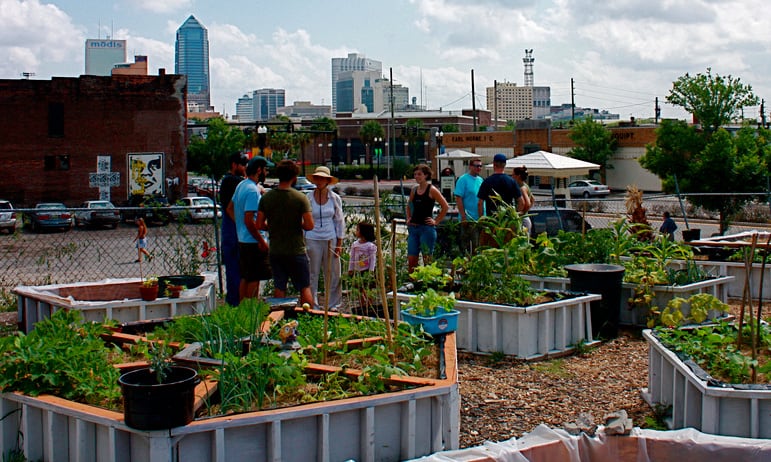Unknown Facts About City Blooming
Unknown Facts About City Blooming
Blog Article
3 Easy Facts About City Blooming Explained
Table of Contents8 Simple Techniques For City BloomingThe Definitive Guide for City BloomingCity Blooming Can Be Fun For Anyone3 Simple Techniques For City BloomingIndicators on City Blooming You Should Know
Fascinated in growing food up for sale in the City of Chicago? Thinking of starting an area yard? Adjustments to the Chicago Zoning Statute permit farming usages like community yards and city farms in numerous components of the city. Below is a listing of regularly asked questions pertaining to the rules and policies that farmers need to take into consideration when planning a metropolitan agriculture job.
The zoning modification does not modify any type of various other codes handling composting, structure licenses, buying or renting City had residential property, company licenses or ecological contamination. There are existing codes that regulate these concerns and they stay in full effect and may apply to your task. Neighborhood yards are commonly owned or taken care of by public entities, civic companies or community-based organizations and kept by volunteers.
Urban ranches grow food that is meant to be marketed, either on a not-for-profit or for-profit basis. Due to their industrial objective, metropolitan farms need a service license. Yes. An area garden is permitted to sell surplus produce that was grown on site if the sales are accessory or subordinate to the garden's main objective explained above.
A Biased View of City Blooming
The amount of garden compost material can not go beyond 25 cubic backyards at any type of offered time according to the requirements in 7-28-715 of the City's Municipal Code. Since the dirt at many brand-new yard websites needs changing, garden compost, soil, timber chips, or other materials can be gotten to create or enhance the expanding room.

If a structure permit is needed then the hoophouse will certainly be taken into consideration an accessory structure. You can discover more regarding the structure authorization requirements by getting in touch with the Department of Structures. The 25,000-square-foot dimension restriction is intended to protect against a solitary neighborhood garden from controling a given block or interfering with the block's existing domestic or commercial personality.
The limit does not use to yards located in Public Open Room (POS) areas. Can there be even more than one area yard that is 25,000 square feet on a single block? Fence is not called for, however, yards that have huge car park areas may be called for to set up fencing or various other landscape design features.
City Blooming Can Be Fun For Anyone
B1 & B2 areas need that all industrial usage activities be conducted indoors. Is fence needed for metropolitan ranches? Fencings might be needed, along with landscape design and testing, for specific car park areas and outside job or storage locations depending on place and the specific activity taking place.
Urban farms call for structure licenses and zoning approvals prior to building (City gardening). Various other types of city evaluation might be called for depending on details frameworks, tasks, size, landscaping, licensing, public heath and stormwater administration issues.
The Department of Company Affairs and Consumer Security can aid determine the particular type of service license that's needed. Off street parking is needed for a lot of business tasks in Chicago. The called for number of car parking spaces is based on the number of staff members working on site and not the square video footage of the expanding room.
The Buzz on City Blooming

Yes. An urban farm can market compost product generated on site, however, the operation needs to adhere to the policies in 7-28-715 of the Chicago Municipal Code. Yes. Aquaponic systems are permitted inside on urban ranches in lots of zoning districts. However, a zoning review and structure permit is needed in order to install structures or systems and an organization certificate is needed as explained over.
Approximately 5 hives or nests of honey may be kept as an accessory use. Nevertheless, beekeepers have to register with the Illinois Division of Agriculture. For even more details about the recommended zoning modification you may call the Division of Housing and Economic Growth, Bureau of Preparation and Zoning at 312.744.8563.
Farming in cities and metropolitan areas A city farm in Chicago. Urban agriculture describes numerous techniques of growing. https://www.pubpub.org/user/daniel-nold, handling, and dispersing food in city locations. The term additionally relates to the area activities of animal husbandry, aquaculture, beekeeping, that site and gardening in a metropolitan context. Urban farming is identified from peri-urban farming, which occurs in backwoods beside suburbs.
City Blooming Can Be Fun For Everyone
, who look for to form social networks established on a common values of nature and community holism. These networks can create by method of formal institutional support, becoming incorporated right into local town planning as a "change community" movement for sustainable city development.
In either instance, the more direct accessibility to fresh vegetable, fruit, and meat products that may be understood with urban agriculture can improve food security and food security while reducing food miles, bring about lower greenhouse gas emissions, thereby contributing to climate change mitigation. Some of the first evidence of urban agriculture originates from Mesopotamia.
Report this page